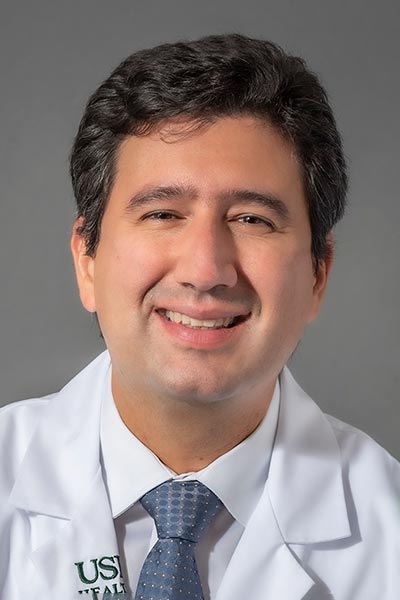Genomic patterns in circulating immune cells, discovered in patients with COVID-19, may hold a clue to reversing the inexorable progression of idiopathic pulmonary fibrosis (IPF), according to a recent study.
Researchers from the University of South Florida (USF) Ubben Center for Pulmonary Fibrosis Research recently published findings on convergent and divergent immune aberrations in COVID-19, post-COVID-19 interstitial lung disease (ILD), and IPF.1

Ubben Center Director, Jose D. Herazo-Maya, MD, Associate Professor and Division Chief of Pulmonary, Critical Care, and Sleep Medicine at the USF Morsani College of Medicine, was the study’s Senior Author. For about 15 years, he has been working to identify genes in immune cells that can predict IPF mortality and open much-needed avenues for saving lives.
“When I started studying idiopathic pulmonary fibrosis, lung transplant was the only treatment that would improve survival of these patients,” he said. “Even now, the drugs that are used to treat IPF only slow down the progression of the disease, and they don’t really have a proven survival benefit.”
The COVID-19 pandemic introduced several new pieces to this puzzle. In a study published in 2021, Dr. Herazo-Maya and his team found that the same genomic risk profile that predicted mortality in IPF also predicted mortality in acute COVID-19 infection. Meanwhile, some patients who survived severe COVID-19 infection began developing pulmonary fibrosis. But unlike persistently progressive forms of fibrosis such as IPF, this post-COVID ILD would improve in a large proportion of patients. This led the USF team to expand upon its previous research.
“The idea was if we find something in these patients [with post-COVID ILD] that is associated with fibrosis resolution, then we can apply that knowledge to patients with IPF,” Dr. Herazo-Maya said.
This latest study looked at peripheral blood mononuclear cells from patients with not only COVID-19 and IPF but also post-COVID ILD. Researchers were able to further differentiate the previously identified predictive profiles for COVID-19 mortality. And while the prior study was based on bulk RNA sequencing, this time, researchers looked at the cellular source of gene expression differences through single-cell RNA sequencing.
They found that COVID-19 was characterized by a genomic imbalance—an increased seven-gene signature in CD14+HLA-DR-/low monocytic myeloid-derived suppressive cells (MDSCs) and decreased expression of 43 genes in T-cell subset populations. The opposite pattern was seen in patients with post-COVID ILD, indicative of a resurgent immune response; while in patients with IPF, the T-cell response remained persistently low.
“We believe that HLA-DR-/low status in COVID-19 MDSCs suppresses the T-cell response, creating a state of immune paralysis. In COVID-19 and in IPF, it probably favors pulmonary fibrosis,” Dr. Herazo-Maya said. “We hypothesized—and we’re going to need future studies to test this—that in IPF, these pathogenic stimuli persist throughout the course of the disease, allowing the T-cell response to remain suppressed. In COVID-19, the response is acute, and it goes away when the virus goes away. But, in IPF, it seems to be repeated and chronic.”
IPF typically has a poor prognosis of less than 10 years based on epidemiology studies, but there remains heterogeneity in survival time in real life; perhaps because of the diversity of endophenotypes or even misdiagnosis. So studies like this one, where researchers are attempting to identify endophenotypes and other markers of fibrosis progression, may help clinicians tailor management for individual patients and provide clarity in the presence of so many uncertainties.
Additional research is being developed to understand the functional mechanisms of certain genes using knock-out and knock-in mouse models, Dr. Herazo-Maya said. Other studies may result from the follow-up questions that are on his mind: If you remove or modulate the HLA-DR-/low MDSCs, will that lead to improvement in T-cell responses or possibly resolution of fibrosis? If so, how would you remove the cells—by filtering them out of the blood or by blocking them with novel drugs?
And, perhaps, can some of this knowledge be applied to other diseases associated with alveolar epithelial cell injury—ARDS, vaping-induced lung injury, severe respiratory infections such as influenza or respiratory syncytial virus, or even something that isn’t currently on the radar?
“A lot of these diseases share similar immune activation pathways,” Dr. Herazo-Maya said. “It’s when you intervene that will make a difference down the road. I think the key is early identification of those changes in the immune system and gene expression—block them or replenish them and, hopefully, that leads to better outcomes. Hopefully, if we ever have another pandemic, we’re prepared with better research and ready to treat these patients in a different way.”
References
1. Tourki B, Jia M, Karampitsakos T, et al. Convergent and divergent immune aberrations in COVID-19, post-COVID-19-interstitial lung disease, and idiopathic pulmonary fibrosis. Am J Physiol Cell Physiol. 2025;328(1):C199-C211. doi:10.1152/ajpcell.00528.2024